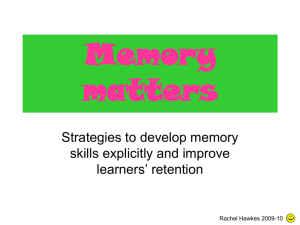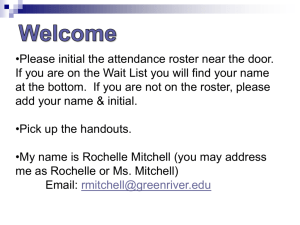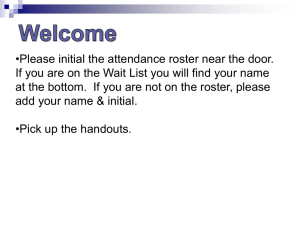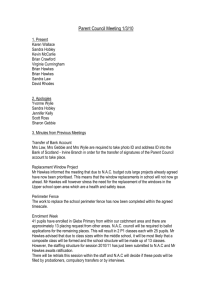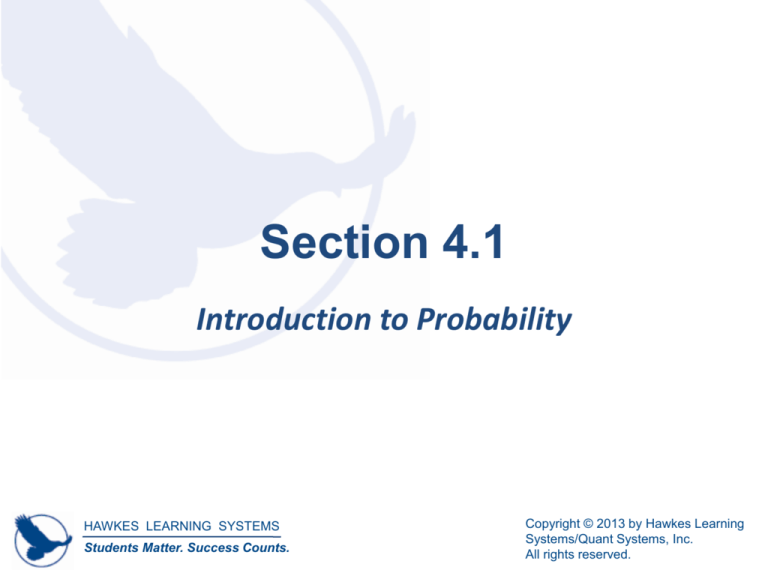
Section 4.1
Introduction to Probability
HAWKES LEARNING SYSTEMS
Students Matter. Success Counts.
Copyright © 2013 by Hawkes Learning
Systems/Quant Systems, Inc.
All rights reserved.
Objectives
o
o
o
o
Identify the sample space of a probability event.
Calculate basic probabilities.
Determine if two events are mutually exclusive.
Determine if two events are independent.
HAWKES LEARNING SYSTEMS
Students Matter. Success Counts.
Copyright © 2013 by Hawkes Learning
Systems/Quant Systems, Inc.
All rights reserved.
Introduction to Probability
A probability experiment (or trial) is any process with a
result determined by chance.
Each individual result that is possible for a probability
experiment is an outcome.
The sample space is the set of all possible outcomes for
a given probability experiment.
An event is a subset of outcomes from the sample
space.
HAWKES LEARNING SYSTEMS
Students Matter. Success Counts.
Copyright © 2013 by Hawkes Learning
Systems/Quant Systems, Inc.
All rights reserved.
Example 4.1: Identifying Outcomes in a Sample
Space or Event
Consider an experiment in which a coin is tossed and
then a six-sided die is rolled.
a. List the outcomes in the sample space for the
experiment.
b. List the outcomes in the event “tossing a tail then
rolling an odd number.”
HAWKES LEARNING SYSTEMS
Students Matter. Success Counts.
Copyright © 2013 by Hawkes Learning
Systems/Quant Systems, Inc.
All rights reserved.
Example 4.1: Identifying Outcomes in a Sample
Space or Event (cont.)
Solution
a. Each outcome consists of a coin toss and a die roll.
For example, heads and a 3 could be denoted as H3.
Using this notation, the sample space can be written
as follows.
H1 T1
H2 T2
H3
T3
Sample space
H4 T4
H5 T5
H6 T6
HAWKES LEARNING SYSTEMS
Students Matter. Success Counts.
Copyright © 2013 by Hawkes Learning
Systems/Quant Systems, Inc.
All rights reserved.
Example 4.1: Identifying Outcomes in a Sample
Space or Event (cont.)
b. Choosing the members of the sample space that fit
the event “tossing a tail then rolling an odd
number” gives the following.
T1, T3, T5
HAWKES LEARNING SYSTEMS
Students Matter. Success Counts.
Copyright © 2013 by Hawkes Learning
Systems/Quant Systems, Inc.
All rights reserved.
Example 4.2: Using a Pattern to List All
Outcomes in a Sample Space
Consider the experiment in which a red six-sided die
and a blue six-sided die are rolled together.
a. Use a pattern to help list the outcomes in the
sample space.
b. List the outcomes in the event “the sum of the
numbers rolled on the two dice equals 6.”
HAWKES LEARNING SYSTEMS
Students Matter. Success Counts.
Copyright © 2013 by Hawkes Learning
Systems/Quant Systems, Inc.
All rights reserved.
Example 4.2: Using a Pattern to List All
Outcomes in a Sample Space (cont.)
Solution
a. Although there are many patterns that could help us
list all outcomes in the sample space, our pattern
will be to start with keeping the red die at 1, and
allowing the blue die to vary from 1 to 6.
HAWKES LEARNING SYSTEMS
Students Matter. Success Counts.
Copyright © 2013 by Hawkes Learning
Systems/Quant Systems, Inc.
All rights reserved.
Example 4.2: Using a Pattern to List All
Outcomes in a Sample Space (cont.)
There are six of these outcomes:
and
.
Next we list all outcomes in which a 2 is rolled on the
red die. Again, there are six outcomes of this form. The
pattern continues until all 36 outcomes are listed.
HAWKES LEARNING SYSTEMS
Students Matter. Success Counts.
Copyright © 2013 by Hawkes Learning
Systems/Quant Systems, Inc.
All rights reserved.
Example 4.2: Using a Pattern to List All
Outcomes in a Sample Space (cont.)
Sample space =
HAWKES LEARNING SYSTEMS
Students Matter. Success Counts.
Copyright © 2013 by Hawkes Learning
Systems/Quant Systems, Inc.
All rights reserved.
Example 4.2: Using a Pattern to List All
Outcomes in a Sample Space (cont.)
Note that rolling a 1 on the red die and a 2 on the blue
die, denoted
, is a different outcome than
rolling a 2 on the red die and a 1 on the blue die,
denoted
.
HAWKES LEARNING SYSTEMS
Students Matter. Success Counts.
Copyright © 2013 by Hawkes Learning
Systems/Quant Systems, Inc.
All rights reserved.
Example 4.2: Using a Pattern to List All
Outcomes in a Sample Space (cont.)
b. To list the outcomes in the event “the sum of the
numbers rolled on the two dice equals 6,” look
through the list above for each individual outcome
where the sum equals 6. Note that 1 + 5 = 6, so the
outcome of rolling a 1 on the red die and a 5 on the
blue die is in the event. The reverse would be rolling a
5 on the red die and a 1 on the blue die. These are
two separate possible outcomes that are both in the
event. The event consists of the following outcomes.
HAWKES LEARNING SYSTEMS
Students Matter. Success Counts.
Copyright © 2013 by Hawkes Learning
Systems/Quant Systems, Inc.
All rights reserved.
Example 4.3: Using a Tree Diagram to List All
Outcomes in a Sample Space
Consider a family with three children. Use a tree
diagram to find the sample space for the gender of
each child in regard to birth order.
Solution
The tree begins with the two possibilities for the first
child—girl or boy. It then branches for each of the other
two births in the family as shown.
HAWKES LEARNING SYSTEMS
Students Matter. Success Counts.
Copyright © 2013 by Hawkes Learning
Systems/Quant Systems, Inc.
All rights reserved.
Example 4.3: Using a Tree Diagram to List All
Outcomes in a Sample Space (cont.)
Key: The notation
GBG indicates the
family shown in red
with a girl, then a
boy, and finally a girl.
HAWKES LEARNING SYSTEMS
Students Matter. Success Counts.
Copyright © 2013 by Hawkes Learning
Systems/Quant Systems, Inc.
All rights reserved.
Example 4.3: Using a Tree Diagram to List All
Outcomes in a Sample Space (cont.)
Using the tree diagram as a guide, the sample space
can be written as follows.
GGG GGB GBG GBB
Sample space
BGG BGB BBG BBB
HAWKES LEARNING SYSTEMS
Students Matter. Success Counts.
Copyright © 2013 by Hawkes Learning
Systems/Quant Systems, Inc.
All rights reserved.
Introduction to Probability
Experimental Probability
In experimental probability, if E is an event, then P(E),
read “the probability that E occurs,” is given by
f
P E
n
where f is the frequency of event E and
n is the total number of times the experiment is
performed.
HAWKES LEARNING SYSTEMS
Students Matter. Success Counts.
Copyright © 2013 by Hawkes Learning
Systems/Quant Systems, Inc.
All rights reserved.
Introduction to Probability
Classical Probability
In classical probability, if all outcomes are equally likely
to occur, then P(E), read “the probability that E occurs,”
is given by
nE
P E
n S
where n(E) is the number of outcomes in the event and
n(S) is the number of outcomes in the sample space.
HAWKES LEARNING SYSTEMS
Students Matter. Success Counts.
Copyright © 2013 by Hawkes Learning
Systems/Quant Systems, Inc.
All rights reserved.
Types of Probability
Subjective probability is an educated guess regarding
the chance that an event will occur.
Experimental probability (or empirical probability) uses
the outcomes obtained by repeatedly performing an
experiment to calculate the probability.
Classical probability (or theoretical probability) is the
most precise type of probability and can only be
calculated when all possible outcomes in the sample
space are known and equally likely to occur.
HAWKES LEARNING SYSTEMS
Students Matter. Success Counts.
Copyright © 2013 by Hawkes Learning
Systems/Quant Systems, Inc.
All rights reserved.
Example 4.4: Identifying Types of Probability
Determine whether each probability is subjective,
experimental, or classical.
a. The probability of selecting the queen of spades out
1
of a well-shuffled standard deck of cards is
.
52
b. An economist predicts a 20% chance that
technology stocks will decrease in value over the
next year.
HAWKES LEARNING SYSTEMS
Students Matter. Success Counts.
Copyright © 2013 by Hawkes Learning
Systems/Quant Systems, Inc.
All rights reserved.
Example 4.4: Identifying Types of Probability
(cont.)
c. A police officer wishes to know the probability that
a driver chosen at random will be driving under the
influence of alcohol on a Friday night. At a
roadblock, he records the number of drivers
stopped and the number of drivers driving with a
blood alcohol level over the legal limit. He
determines that the probability is 3%.
HAWKES LEARNING SYSTEMS
Students Matter. Success Counts.
Copyright © 2013 by Hawkes Learning
Systems/Quant Systems, Inc.
All rights reserved.
Example 4.4: Identifying Types of Probability
(cont.)
Solution
a. All 52 outcomes are known and are equally likely to
occur, so this is an example of classical probability.
b. The economist is giving an educated guess;
therefore, this is an example of subjective
probability.
c. The police officer’s probability is based on the
evidence gathered from the roadblock. Because not
all drivers were evaluated at that roadblock, the
probability is experimental.
HAWKES LEARNING SYSTEMS
Students Matter. Success Counts.
Copyright © 2013 by Hawkes Learning
Systems/Quant Systems, Inc.
All rights reserved.
Example 4.5: Calculating Classical Probability
Beck is allergic to peanuts. At a large dinner party one
evening, he notices that the cheesecake options on the
dessert table contain the following flavors: 10 slices of
chocolate, 12 slices of caramel, 12 slices of peanut
butter chocolate, and 8 slices of strawberry. Assume
that the desserts are served to guests at random.
a. What is the probability that Beck’s cheesecake
contains peanuts?
b. What is the probability that Beck’s dessert does not
contain chocolate?
HAWKES LEARNING SYSTEMS
Students Matter. Success Counts.
Copyright © 2013 by Hawkes Learning
Systems/Quant Systems, Inc.
All rights reserved.
Example 4.5: Calculating Classical Probability
(cont.)
Solution
a. There are 12 slices of chocolate peanut butter
cheesecake, and 10 + 12 + 12 + 8 = 42 pieces of
cheesecake total. The probability is then calculated
as follows.
nE
P peanut butter chocolate
n S
12 2
0.2857
42 7
HAWKES LEARNING SYSTEMS
Students Matter. Success Counts.
Copyright © 2013 by Hawkes Learning
Systems/Quant Systems, Inc.
All rights reserved.
Example 4.5: Calculating Classical Probability
(cont.)
b. There are 12 + 8 = 20 slices of cheesecake that do
not contain chocolate. The probability of being
served one of these desserts is calculated as follows.
nE
P not chocolate
n S
20 10
0.4762
42 21
HAWKES LEARNING SYSTEMS
Students Matter. Success Counts.
Copyright © 2013 by Hawkes Learning
Systems/Quant Systems, Inc.
All rights reserved.
Example 4.6: Calculating Classical Probability
Consider a beginning archer who only manages to hit
the target 50% of the time. What is the probability that
in three shots, the archer will hit the target all three
times?
Solution
For each shot, the arrow will either hit the target or
miss the target. Note that these two outcomes are
equally likely here since his chance of hitting the target
is 50%. To determine how many outcomes are in the
sample space, we can use either a pattern or a tree
diagram.
HAWKES LEARNING SYSTEMS
Students Matter. Success Counts.
Copyright © 2013 by Hawkes Learning
Systems/Quant Systems, Inc.
All rights reserved.
Example 4.6: Calculating Classical Probability
(cont.)
Let’s use a tree diagram.
HAWKES LEARNING SYSTEMS
Students Matter. Success Counts.
Copyright © 2013 by Hawkes Learning
Systems/Quant Systems, Inc.
All rights reserved.
Example 4.6: Calculating Classical Probability
(cont.)
Notice that this gives 8 possible outcomes for the three
shots, only 1 of which consists of hitting the target all
three times. Thus, the probability of the novice archer
hitting the target three times in a row is calculated as
follows.
nE
P all three hits
n S
1
8
0.125
HAWKES LEARNING SYSTEMS
Students Matter. Success Counts.
Copyright © 2013 by Hawkes Learning
Systems/Quant Systems, Inc.
All rights reserved.
Example 4.7: Calculating Classical Probability
Consider a family with six boys. What is the probability
that the seventh child will also be a boy?
Solution
Many people would say that this family is due to have a
girl, but let’s consider the mathematics. Suppose we
took the time to write down every possible
combination for birth orders of seven children. Because
the family already has six boys, we would have to mark
out all combinations that contain a girl in the first six
children.
HAWKES LEARNING SYSTEMS
Students Matter. Success Counts.
Copyright © 2013 by Hawkes Learning
Systems/Quant Systems, Inc.
All rights reserved.
Example 4.7: Calculating Classical Probability
(cont.)
The only two outcomes left in the sample space would
be BBBBBBG and BBBBBBB. The probability of baby
number seven being a boy is then
nE
P all seven boys
n S
1
2
0.5,
just as with any other pregnancy!
HAWKES LEARNING SYSTEMS
Students Matter. Success Counts.
Copyright © 2013 by Hawkes Learning
Systems/Quant Systems, Inc.
All rights reserved.
Example 4.8: Calculating Classical Probability
In biology, we learn that many diseases are genetic. One
example of such a disease is Huntington’s disease, which
causes neurological disorders as a person ages. Each person
has two huntingtin genes—one inherited from each parent.
If an individual inherits a mutated huntingtin gene from
either of his or her parents, he or she will develop the
disease. On the TV show House, the character who Dr.
House calls “13” inherited this disease from her mother.
Assume for a moment that “13” has a child with a person
who has two healthy huntingtin genes. What is the
probability that her child will develop Huntington’s disease?
HAWKES LEARNING SYSTEMS
Students Matter. Success Counts.
Copyright © 2013 by Hawkes Learning
Systems/Quant Systems, Inc.
All rights reserved.
Example 4.8: Calculating Classical Probability
(cont.)
Solution
So far, we have listed the outcomes of an experiment in
an orderly fashion and by using a tree diagram. In
biology, we commonly use a Punnett square to help list
the outcomes of a genetic experiment. The mother’s
two alleles of a specific gene are listed along one side
of a square, and the father’s two alleles of the gene are
listed along an adjacent side. We then fill in the square
by writing in the four possible combinations of alleles
inherited—one from each parent.
HAWKES LEARNING SYSTEMS
Students Matter. Success Counts.
Copyright © 2013 by Hawkes Learning
Systems/Quant Systems, Inc.
All rights reserved.
Example 4.8: Calculating Classical Probability
(cont.)
For this experiment, we know that each person has two
huntingtin genes. We will label a mutated huntingtin
gene with an uppercase “H” and an unaffected
huntingtin gene with a lowercase “h.” For this
experiment, the mother has at least one mutated gene.
Let’s assume it is just one, so her genetic makeup
would be written as Hh. She has a child with someone
who has no affected huntingtin genes, so his genetic
makeup can be written as hh. Let’s write these gene
combinations on the sides of a Punnett square.
HAWKES LEARNING SYSTEMS
Students Matter. Success Counts.
Copyright © 2013 by Hawkes Learning
Systems/Quant Systems, Inc.
All rights reserved.
Example 4.8: Calculating Classical Probability
(cont.)
So the four possibilities for the child’s genes are
{Hh, Hh, hh, hh}. Someone only has to
have one mutated gene to develop the
disease, so that means two of the four
combinations would result in a child
having the disease, {Hh, Hh}. Thus, if
E = the event of the child inheriting
a mutated huntingtin gene, then the probability that E
occurs is calculated as follows.
HAWKES LEARNING SYSTEMS
Students Matter. Success Counts.
Copyright © 2013 by Hawkes Learning
Systems/Quant Systems, Inc.
All rights reserved.
Example 4.8: Calculating Classical Probability
(cont.)
nE
P E
n S
2 1
0.5
4 2
This means that “13” has a 50% chance of passing on
the disease to a child. This is true for anyone with
Huntington’s disease. The probability goes up if the
other parent also has the disease.
HAWKES LEARNING SYSTEMS
Students Matter. Success Counts.
Copyright © 2013 by Hawkes Learning
Systems/Quant Systems, Inc.
All rights reserved.

